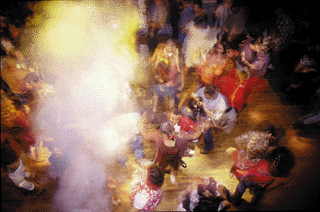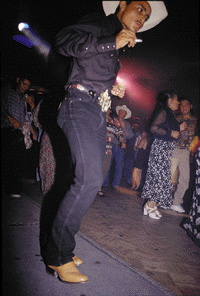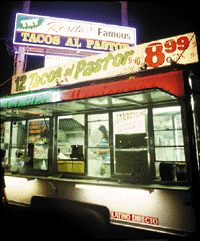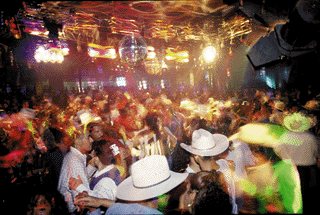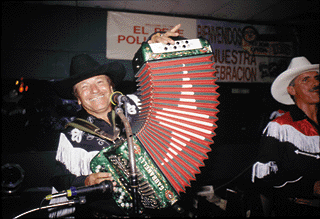¿Quieres Chanclar?
East Riverside's "Latin Strip"
By James E. Garcia, Fri., Nov. 7, 1997
|
|
Omar's belt buckle is the size of small land mine. It reads "Mexico" so I figure there's a good chance he didn't buy it at La Dillard's in Barton Creek Mall. It's the kind of buckle you could only wear without bruising your gut if you had a 29-inch waste. Make that 27. My potbellied tios used to wear those chingon buckles, but I think the goal there was to keep the shirt buttons at the waist from blasting across the room and mortally wounding someone. If only we'd had more buttons at the Alamo.
"It's made of pure silver!" shouts Omar above the din of music at East Riverside's Club Latino, patting the buckle like a favorite pet. "Es de pura plata!"
Plata, silver, is still cheap and abundant in Mexico. A few years ago in a Nuevo Laredo gift shop, I watched with amusement as an American tourist -- his calves glowing from his day in the August sun -- and his Betty Crocker-wife struggled to decipher a sign reading, "Penes de plata, $60." Pene is the Spanish word for penis.
"They're $60 each," I told them. His wife sneered at me. I think she thought I was a male prostitute.
"$60!" the man shrieked, as if he could find a silver-plated penis back home for less than $150.
About Omar:
|
|
Near the entrance, a couple of gnarly looking bouncers in black T-shirts with the word "Security" emblazoned across the backs are checking IDs and poking fun at a drunk transvestite. I'll call her La Tina, because she reminds me of a Latina Tina Turner -- with hairy legs.
The crowd is young. Most are in their twenties. Based on their clothes and distinct Spanish dialects, I assume a lot of them are not -- as they say -- from around these parts. In fact, Club Latino's core clientele are recent immigrants -- mostly Mexicans and Central Americans -- though local working-class Chicanos are part of the mix. As amazing as this may seem, it's a crowd that would stand out on Sixth Street. The white suede leather western jacket and two-tone cowboy boots Omar's compadres are sporting are not meant to be retro or Tejano chic.
And Club Latino isn't the only dance club located on Riverside between Congress Avenue and Pleasant Valley Drive that's drawing throngs of Latin music lovers from throughout Central Texas and beyond. In the past several years, East Riverside has become a kind of Sixth Street for Latin music with six different clubs on the "Latin Strip" offering everything from norteño and Tejano to salsa, merengue, international hip-hop, and rock en espanol. All the clubs, with the exception of Club Rio at Congress and East Riverside, are east of the interstate. There are other Latin music clubs in town -- Tejano Ranch, Miguel's, Las Palmeras, and Calle Ocho, just to name a few -- but East Riverside Drive is quickly becoming the place to go si quieres chanclar (rough translation: Wear your dancing shoes.)
Decked out in a pair of tight-fitting, jet-black Wranglers, a cowboy hat, black-and-white boots, and a two-tone western shirt, Omar -- my unwitting protagonist -- is bouncing off the walls. Minh, my photographer, wants a picture, but Omar just wants to get back on the dance floor. Knowing I only have a minute or so before he bolts, I spit out a few questions.
|
|
"Coahuila!" he says proudly. "Soy Mexicano." A native of the northern Mexican border state of Coahuila, Omar, 18, says he's a construction worker who lives to dance (John Travolta eat your heart out).
"I have been coming here for a year," he says in his rural norteño dialect. "At times I go to Club Carnaval (right down the street), but here I am with my people. For me, dancing is like playing a musical instrument. On the dance floor, I am a musician."
For a moment, I consider asking Omar if he's in the country legally, but I decide that might freak him out. In any event, seconds later, the interview is over and Omar is back on the dance floor slip-sliding to a Colombian cumbia. The deejay spins a mix of Tejano, norteño, and Latin-techno tunes, and as the crowd on the dance floor swells and the fog machine kicks on, I slip out the front door past La Tina -- fighting the urge to whisper in her ear, "What's love got to do with it?"
One block east of Club Latino, at the other end of the Bingo Hall! parking lot, sits Club Kao's. You may have heard the commercials on 101X: (in radio announcer's voice) "Thursday night! It's the world-famous $1,000 legs contest! That's $500 a leg!" Don't ask me why, but I love that. Still, I wonder, does a one-legged bombshell really stand a chance of winning $500?
Confession: For the longest time I thought Club Kao's was a retro-disco joint -- which only proves how rarely this wannabe-Chicano listens to the local Tejano stations that run most of the club's advertisements. Its "world famous" legs contest aside, Club Kao's is known for its "Tejano pop" and "international dance" deejays.
One of those jocks is Daryl "Doc" Baptist. Doc has worked at Kao's for eight years and says that East Riverside has been through some major changes in that time. Used to be that the strip was better known for clubs like the The Back Room. He agrees that East Riverside has acquired a distinctly Latin persona -- particularly in the last three to five years. But there's a little something for everyone.
|
|
Club Kao's caters to a college-age crowd of Generation MeX-ers -- young, upwardly mobile Tejanos, Chicanos, and other Hispanos. The deejays play a terminally upbeat mix of Tejano, Tejano pop, Top 40, rock en espanol, and international dance -- mostly Latin American bands. Doc said the dress code is "strictly enforced," meaning, "no shirts without collars, no sneakers, no baggy pants, no baseball caps. Nothing that has to do with gang activity."
Club Carnaval, two blocks east on Riverside, is arguably the most popular club on the strip, and has carved out a niche as the classier version of Club Latino. While the latter club features a working-stiff, pool-hall ambiance, Carnaval's decor exudes a psychedelic Aztec quality -- lots of black fluorescent lights and glowing fuchsia sun gods. Carnaval turns high-tech kitsch when the deejays aim their video cameras at the dance floor. Most ignore the gimmick, though a few steal glances at the television monitors.
"I come [here] every week -- maybe two times a week," says Eva Cervantes, who's been to every Latino dance club in town and asserts that Carnaval is by far her favorite, because they play everything from merengue and salsa to banda and Tejano. "Here, you dance!" she says. "At the other clubs, the guys stand around too much."
Bolting Club Carnaval, Minh and I traverse a jam-packed parking lot and cross Riverside moving towards Fast Freddy's Hair Salon, home of the $5 haircut. No kidding, a $5 haircut. They used to give customers free hot dogs too, but that became a bit unmanageable.
Freddy's is a great landmark. It has the biggest sign on the corner and is flanked by two hot spots, Club La Noche and El Pepe's Polkas. Up until September, the former was El Coyote, a roots norteño and conjunto joint. Co-owner and manager Jose Romero says Club La Noche will be going mano a mano with Club Latino and Club Carnaval. While El Coyote was known for its Mexican norteño bands, Club La Noche will -- like its competitors -- feature lots of cumbias, musica Colombiana, y musica tropical. Unlike Club Latino and Club Carnaval, however, Romero will be serving up live music every night.
"We've been here one month," says Romero. "If God's willing, we're going to make this work." Romero is determined, though he has his work cut out for him. On the night I stopped by, he was still taking business calls on the pay phone in the lobby.
Around the corner at El Pepe's Polkas, norteño is king, and most nights you'll find the club's owner-manager Antonio Villanueva working the bar. A former matador, Villanueva says Pepe's opened three years ago. Like Club La Noche, this night spot doesn't do deejays, but unlike Romero, Villanueva is not particularly interested in chasing the younger market. His is a club geared to gente mayor -- older people -- not necessarily those who are retired, rather those who are more interested in rocking on the dance floor than anyone's front porch.
Sunday afternoons, for example, caters to seniors. Any band booked to play the Thursday, Friday, and Saturday night slot knows they'll be pulling a double-shift on Sunday, doing an afternoon gig then another one that night.
On one recent Sunday, Alicia Cuevas and three of her comadres spent the afternoon sipping wine coolers and hoping against hope to catch the eye of some dashing young caballero -- the goal here being not so much to "get a man" as it is to find a good dance partner. (Incidentally, comadre translates literally as "godmother," but usually means something more akin to what African-American women imply when they use the term "sister.")
Pepe's Polkas is something of a Latino honky-tonk. The closest thing to pretense is the guy with the sweaty, hairless, cocoa-colored chest in a black silk shirt unbuttoned to his waist (but tucked in). Y para las mujeres (as for the women), the look of love has to be the supertight mini-falda, Saran-wrapped around a pair of supernalgas I pray I never see poolside at Fiesta Gardens. Aye no mujer!
Most of the crowd, however, is far more modest; it's CMT (Country Music Television) meets Univision. Alicia, for instance, is wearing her wedding-reception best -- not too prim, and not too shiny. "We come every once and awhile," she tells me. "That way we aren't always stuck in the house. It's a good thing to do after church. And since we don't have kids in the house, we think, `Por que no? [Why not?].'" One of the other women at the table nods her approval, though her gaze remains fixed on the dimly lit dance floor.
The rituals here have an old-world charm -- as chauvinistic as they may seem to outsiders. As the band starts playing a number, the men in the club approach the women, almost always seated, and extend their hands. If a woman wants to dance, she takes his hand and follows silently. If not, she stares straight ahead, brushing him off with a slight shake of her head. If he persists, the shake becomes vigorous. Like any bar in town, some guys don't get it. Señor! No means no! Como chingas!
|
|
The evening crowd at Pepe's is younger, though somewhat older than the clientele at places like Club Latino and Club Carnaval. Villanueva says the nightly cover charge, as with most of the Latino clubs on Riverside, is lower for women than men. On Saturday nights, los hombres pay up to $10 a head, while las mujeres are charged $6.
"Why the difference?" I ask, feigning cultural naïvete.
"Because the men can afford to pay," says Villanueva, "and the women, the ones who work, don't earn as much as the men." Something tells me he didn't have to read the latest census reports about the income disparity levels between male and female workers to figure that one out.
Over at Club La Noche, Romero has a similar policy, though he takes a more bottom-line approach. "The women attract the men. The more women who come to my club, the more men who drink in my club."
Got it.
Finalmente, there's Club Rio near the intersection of Congress and East Riverside -- that's right next door to Pinky's Pagers. Of East Riverside's Latino clubs, Club Rio and Club Kao's are the most alike, though the management at Rio delivers a dizzyingly eclectic array of musical formats.
"This used to be a Tejano club," says Rio's general manager Willie Cisneros, who has run Tejano bars for 16 years. "But in the past two years, Tejano has become less popular. We found we couldn't survive with just putting on Tejano bands every night."
To keep his short-attention span customers interested, Cisneros pulls out all the stops. Wednesday night at Club Rio, deejays spin a familiar mix of disco, Tejano, Tejano Pop, and international hip-hop. Thursday night is international night, featuring American and Latin American hip-hop, Latin pop, salsa, and merengue. Most Fridays, Rio has live Tejano bands, including all the big names: Jay Perez, Los Chamacos, Roberto Pullido y Los Classicos, La Tropa F, and La Mafia. Saturday is reserved for international dance and rock en espanol and Sunday night is R&B and soul.
How do customers know what to expect when they walk in the door?
"They get trained," says Cisneros, who also owns Cisneros Entertainment, which publishes Music World, a 'zine that covers Latin, international, and country music. "And we advertise a lot on radio stations."
Pete Cevallos and his fiancee Linda Mendoza, both 24, say Rio, Kao's and Las Palmeras just north on Congress are where they go to get their Latino fix. "We like Sixth Street," said Cevallos, who lives and works in Georgetown, "but it gets real crowded sometimes. The Latino clubs are cool because I can meet someone I know from home or the [Rio Grande] Valley or Houston."
Mendoza added, "We stay here for a while, then we go to Club Kao's or Carnaval. When my cousins come from Houston, I take them to Riverside. It's more Hispanic."
Pues, asi es.
James E. Garcia is a Phoenix-based journalist, playwright and communications consultant. He writes commentary for AZMirror.com. He also is the editor and publisher of VanguardiaArizona.com, which covers Latino news statewide. Email Garcia at jegcolumn@gmail.com. [Author bio updated July 2019.]





